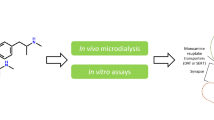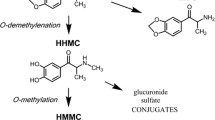Abstract
Phenylethylamine and its monomethylated derivatives p-methylphenylethylamine, α-methylphenylethylamine, phenylethylamine itself, N-methylphenylethylamine, o-methylphenylethylamine, and β-methylphenylethylamine, readily cross the blood-brain barrier showing a brain-uptake index (%) ± SD (water considered 100 %), of 108 ± 11, 98 ± 14, 83 ± 6, 78 ± 11, 62 ± 7 and 56 ± 6, respectively (injection of tritiated water and 100 μg standard amine, which was measured by gas-liquid chromatography). Similar brain-uptake index values (determined by double isotope counting) were obtained for phenylethylamine and α-methylphenylethylamine (amphetamine) after the injection of tritiated water and C14-labeled amine (either 3 μg or when added 100 μg standard compound), suggesting that they entered the brain via passive diffusion. Accordingly, both amines distributed rather evenly in the various rat brain areas examined: uptake index (%) ± SD (double isotope counting; non-, and diluted labeled amine) for phenylethylamine (89 ± 8 and 78 ± 7, 83 ± 9 and 86 ± 9, 96 ± 6 and 84 ± 7) and for α-methylphenylethylamine (88 ± 11 and 87 ± 9, 93 ± 14 and 87 ± 11, 97 ± 12 and 87 ± 9) for the cerebellum, frontal cortex, and striatum, respectively. These results will aid a greater understanding of the pharmacological and behavioral effects observed after the administration of phenylethylamine and methylphenylethylamine derivatives.
Similar content being viewed by others
Abbreviations
- PEA:
-
Phenylethylamine
- p-MePEA:
-
Para-methylphenylethylamine
- α-MePEA:
-
α-Methylphenylethylamine
- AMPH:
-
Amphetamine
- N-MePEA:
-
N-Methylphenylethylamine
- o-MePEA:
-
o-Methylphenylethylamine
- β-MePEA:
-
β-Methylphenylethylamine
- BBB:
-
Blood-brain barrier
- BUI:
-
Brain-uptake index
- GLC:
-
Gas-liquid chromatography
- DIC:
-
Double isotope counting
References
Shulgin A, Shulgin A (1991) Phenethylamines I have known and loved: a chemical love story. Transform Press, Berkeley
Berry MD (2004) Mammalian central nervous system trace amines. Pharmacologic amphetamines, physiologic neuromodulators. J Neurochem 90:257–271
Mosnaim AD, Wolf ME (eds) (1978) Non-catecholic Phenylethylamines. Part 1: phenylethylamine: biological mechanisms and clinical aspects. Marcel Dekker, New York
Chevesich JA, Callaghan OH, Wolf ME, Mosnaim AD (1983) Behavioral effects in mice produced by monosubstituted phenylethylamines. Fed Proceedings 733–734
www.healthremedies.com. Accessed 2012, Copyrights 2008–2012
Lindemann L, Hoener MC (2005) A renaissance in trace amines inspired by a novel GPCR family. Trends Pharmacol Sci 26(5):274–281. http://www.ncbi.nlm.nih.gov/pubmed/15860375
Borowsky B, Adham N, Jones KA, Raddaz R, Artymyshyn R, Ogozalek KL et al (2001) Trace amines: identification of a family of mammalian G protein-coupled receptors. Proc Natl Acad Sci USA 98:8966–8971
Bunzow JR, Sonders MS, Arttamangkul S et al (2001) Amphetamine, 3,4 methylenedioxymethamphetamine, lysergic acid diethylamide, and metabolites of the catecholamine neurotransmitters are agonists of a rat trace amine receptor. Mol Pharmacol 60:1181–1188
Parker EM, Cubeddu LX (1988) Comparative effects of amphetamine, phenylethylamine and related drugs on dopamine efflux, dopamine uptake and mazindol binding. J Pharmacol Exp Ther 245:199–210
Shannon and DeGregorio (1982) Self administration of the endogenous trace amines beta-phenethylamine, N-methyl-phenethylamine and phenylethanolamine in dogs. J Pharmacol Exp Ther 222:52–60
Oldendorf WH (1970) Measurement of brain uptake of radiolabeled substances using a tritiated water internal standard. Brain Res 24:1629–1639
Mosnaim AD, Callaghan OH, Wolf ME (1981) Determination of non-catecholic phenylethylamines and monomethylated derivatives of phenylethylamines. J Chromatogr Biomed Appl 224:481–487
Ambikanandan M, Ganesh S, Aliasgar A, Shrenik PS (2003) Drug delivery to the central nervous system: a review. J Pharm Pharm Sci 6(2):252–273
Mosnaim AD, Karoum F, Zeller A, Callaghan OH, Singh SP, Wolf ME (1982) Platelet monoamine oxidase activity and plasma levels of non-catecholic phenylethylamines in insulin-dependent diabetic subjects. Clin Chim Acta 126:237–242
Fischer EE, Heller BB, Miro AH (1968) Beta-phenylethylamine in human urine. Arzneimittelforschung 18(11):1486
Inwang EE, Mosnaim AD, Sabelli HC (1973) Isolation and characterization of phenylethylamine and phenylethanolamine from human brain. J Neurochem 20:1469–1473
Saavedra JM (1974) Enzymatic isotopic assay for and presence of Β-phenylethylamine in brain. J Neurochem 22:211–216
Karoum F, Nasrallah H, Potkin S, Chuang L, Moyer-Schwing J, Phillips I, Wyatt RJ (1979) Mass fragmentography of phenylethylamine, m- and p-tyramine and related amines in plasma, cerebrospinal fluid, urine, and brain. J Neurochem 33(1):201–212
Mosnaim AD, Wolf ME (eds) (1978) Non-catecholic phenylethylamines. Part 2: phenylethanolamine, tyramines and octopamine. Marcel Dekker, USA
Hansen TR, Greenberg J, Mosnaim AD (1980) Direct effect of phenylethylamine upon isolated vascular smooth muscle of the rat. Eur J Pharmacol 63:95–101
Hauger R, Skolnick P, Martin L (1982) Specific 3Hbeta-phenylethylamine binding sites in rat brain. Eur J Pharmacol 83:147–148
Sabelli HC, Mosnaim AD (1974) Phenylethylamine hypothesis of affective behavior. Am J Psychiatr 131:695–699
Boulton AA (1980) Trace amines and mental disorders. Can J Neurol Sci 7:261–263
Wolf ME, Mosnaim AD (1983) Phenylethylamine in neuropsychiatric disorders. Gen Pharmacol 14(4):385–390
Sotnikova TD, Zorina OI, Ghisi V, Caron MG, Gainetdinov RR (2008) Trace amine associated receptor 1 and movement control. Parkinsonism Relat Disord 14(Suppl 2):S99–S102
Yang HYT, Neff NH (1973) B-Phenylethylamine: a specific substrate for type B monoamineoxidase in brain. J Pharm Exp Ther 187:365–371
Durden DA, Davis BA (1993) Determination of regional distribution of phenylethylamine and meta- and para-tyramine in rat brain regions and presence in human and dog plasma by an ultra-sensitive negative chemical ion gas chromatography-mass spectrometric (NCI-GC-MS) method. Neurochem Res 18:995–1002
Borowsky B, Adham N, Jones KA, Raddatz R, Artymyshyn R, Ogozalek KL, Durkin MM, Lakhlani PP, Bonini JA, Pathirana S, Boyle N, Pu X, Kouranova E, Lichtblau H, Ochoa FY, Branchek TA, Gerald C (2001) Trace amines; identification of a family of mammalian G protein-coupled receptors. Proc Natl Acad Sci USA 98(16):8966–8971
Maguire JJ, Barriocanal FP, Davenport AP (2002) Are vasoconstrictor responses to tyramine in human blood vessels, in vitro, mediated by the orphan trace amine receptor, TA1. Br J Pharmacol 131:71
Lewin AH (2006) Receptors of mammalian trace amines. AAPS J 8(1):E138–E145
Fehler M, Broadley KJ, Ford WR, Kidd EJ (2010) Identification of trace-amine-associated receptors (TAAR) in the rat aorta and their role in vasoconstriction by β-phenylethylamine. Naunyn Schmiedebergs Arch Pharmacol 82(4):385–398
www.wada-ama.org World Anti-Doping Agency (Accessed 2012)
Sabelli HC, Vazquez AJ, Mosnaim AD, Madrid-Pedemonte L (1974) 2-Phenylethylamine as a possible mediator for 9-tetrahydrocannabinol-induced stimulation. Nature 248:144–145
Mosnaim AD, Wolf ME, Zeller EA (1984) Degradation kinetics by MAO of PEA derivatives. A model for the molecular basis of their analgesic and behavioral effects? In: Boulton A, Baker G, Dewhurst W, Sandler M (eds) Neurobiology of trace amines. Humana Press, New Jersey, pp 299–306
Davenport AP (2003) Peptide and trace amines orphan receptors: prospects for new therapeutic targets. Curr Opin Pharmacol 3:27–34
Branchek TA, Blackburn TP (2003) Trace amines receptors as targets for novel therapeutics: legend, myth and fact. Curr Opin Pharmacol 3(1):90–97
Berry MD (2007) The potential of trace amines and their receptors for treating neurological and psychiatric diseases. Rev Recent Clin Trials 2:3–19
Xie Z, Miller GM (2008) Beta-phenylethylamine alters monoamine transporter function via trace amine-associated receptor 1: implication for modulatory roles of trace amines in brain. J Pharmacol Exp Ther 325(2):617–628
Acknowledgments
This research was supported, in part, by The National Migraine Foundation, Chicago, IL. We appreciate the skilful technical assistance of Mr. Sampsom Myles.
Conflict of interest
The authors declare that they have no conflict of interest.
Author information
Authors and Affiliations
Corresponding author
Rights and permissions
About this article
Cite this article
Mosnaim, A.D., Callaghan, O.H., Hudzik, T. et al. Rat Brain-Uptake Index for Phenylethylamine and Various Monomethylated Derivatives. Neurochem Res 38, 842–846 (2013). https://doi.org/10.1007/s11064-013-0988-1
Received:
Revised:
Accepted:
Published:
Issue Date:
DOI: https://doi.org/10.1007/s11064-013-0988-1




